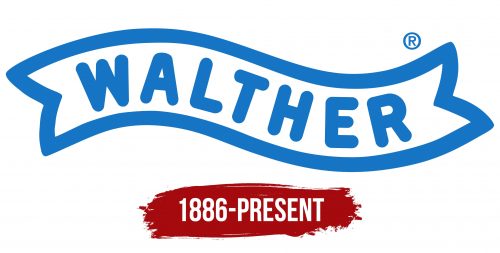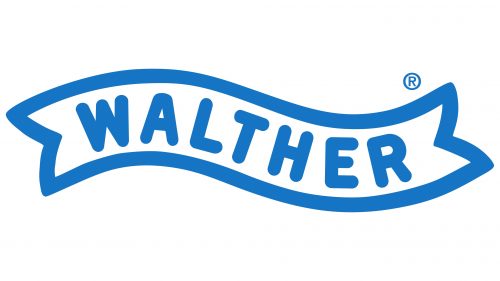The Walther logo delicately represents the firearms industry, creating a festive atmosphere – confirming the brand’s success in its niche market. The emblem gently reflects the complex theme, adhering to ethical and moral standards.
Walther: Brand overview
In 1886, Carl Walther established a modest gun shop in the German town of Zella-Mehlis, Thuringia, marking the beginning of the Walther company’s history. The company’s initial focus was on producing sporting and hunting rifles.
The enterprise made a name for itself early on as a manufacturer of fine guns. Experienced gunsmith Carl Walther oversaw each step of manufacture, guaranteeing the high caliber of the final goods.
An important turning point in the business’s history occurred in 1908 when the firm unveiled the Model 1, its first semi-automatic handgun. This small 6.35mm handgun quickly became popular among average people.
The company kept refining its semi-automatic pistol lineup throughout the 1920s. The PP (Polizeipistole) pistol, one of the first double-action handguns to be successful, was initially released in 1929. The little PPK (Polizeipistole Kriminal) variety came next, becoming well-known worldwide because of its usage in James Bond movies.
The manufacturer experienced substantial expansion during the 1930s. The business produced several new handgun variants, including the P38, which the Wehrmacht designated as the standard-issue handgun in 1938.
World War II significantly impacted the enterprise’s operations. The business had to produce greater quantities of P38 handguns for military use. The Zella-Mehlis facility was demolished after it fell into the Soviet occupation zone following the war.
The founder’s son, Fritz Walther, started again in Ulm, West Germany, in 1953. The business first produced air rifles but quickly switched back to actual guns.
For the company, the 1960s and 1970s were a time of healing and development. The business created new models, such as the P5, which was taken up by the German police, and continued to produce well-known pre-war types like the PP and PPK.
One of the first handguns with a polymer frame was the P99, which debuted in 1993. Police enforcement organizations used this handgun throughout several nations.
Innovation and continued development typified the 2000s. The manufacturer joined the Umarex group of companies in 2001, bringing more resources for growth.
The PPQ (Police handgun Quick Defense) handgun, which the brand debuted in 2011, won accolades for its trigger quality and ergonomics.
The CCP (Concealed Carry Pistol) was introduced in 2013 and reduced recoil using the novel Softcoil gas system.
The company brought back the usage of a steel frame in its sporting pistols with the release of the Q5 Match Steel Frame in 2019.
The enterprise debuted a brand-new handgun model in 2020 under PDP (Performance Duty Pistol). Both law enforcement and civilian shooters’ needs were taken into consideration when designing this handgun. The PDP had an upgraded sighting system, an ergonomic grip, and a textured upgrade for better weapon control.
The manufacturer introduced the PDP Compact, a more compact variant, in 2021, expanding the PDP series. With its smaller size and all the benefits of the full-size model, this model is perfect for concealed carry. The business also started providing the PDP in several configurations to accommodate a wider range of users.
In 2022, the brand concentrated on advances in firearm production. The company started using innovative 3D printing technology to produce firearm components and prototypes. This made creating new models more quickly and producing higher-quality parts possible. The business also unveiled a revised iteration of its vintage PPK handgun with improved ergonomics and contemporary materials.
In 2023, the manufacturer focused on growing its sports shooting division. The Q5 Match SF (Steel Frame) Pro is a new competition pistol series for real-world shooting events.
The enterprise achieved a breakthrough in digitalizing its goods in 2024. The business unveiled a “smart” handgun design that could gather shooting data for study and skill development in addition to having an electronic owner identification system.
The company is still growing, adjusting to the shifting weapons market while maintaining its reputation for quality and dependability.
Meaning and History
What is Walther?
It is a German firearms manufacturer known for making pistols, rifles, and other firearms. The company, officially called Carl Walther GmbH, has a long history in the firearms industry. The most famous models include the Walther PPK, which fictional spy James Bond used, and the Walther PPQ, known for its advanced ergonomics and striker-fired trigger mechanism. Firearms are widely used by law enforcement, military, and civilian shooters around the world. The company continues to develop advanced firearms that combine state-of-the-art technology.
1886 – today
One of the oldest firearms companies in the world chose an unusual logo. It does not mention the industry it represents, as it contains no thematic elements. On the contrary, it instills joy, hinting at carefreeness and a festive mood. This encapsulates the idea of firearms: a defensive tool that provides protection, allowing one to live fully, remain calm, and enjoy each new day.
In other words, the brand did not follow the typical path of using technical or firearm details; it opted for lightness, elegance, simplicity, and positivity. These elements suggest the need to maintain personal safety in emergencies and composure. The core of the Walther logo is a ribbon with triangular cutouts at the ends. It flutters invitingly in the wind, resembling a festive web banner.
The ribbon is drawn with a thick outline, conveying strength and masculinity. At the same time, it does not appear heavy but rather light and airy. There is also a playful element, as the ends of the triangular cuts are slightly rounded—lacking sharpness, indicating safety. The ribbon’s wavy form adds dynamism and freshness to the logo. The inscription inside mirrors this movement.
The name of the firearms company is written in an extra-bold font. It flows smoothly in the wind, with the first letters raised and the rest lowered, creating a wave effect. Although the glyphs have no serifs, readability is somewhat hindered by the narrow letter-spacing: it is so tight that it creates minimal gaps. However, the situation is saved by the wide spacing between the symbols: they are optimally distanced from each other, not merging into one spot or touching the ribbon’s edges.
The font is inflated, making the inscription resemble the emblem of a children’s company, a cartoon, or a TV show intro, giving the brand a positive impression. It also adds softness and elegance to the logo. At the same time, the thickness of the letter lines matches the outline’s thickness, and the roundness of the glyphs harmonizes perfectly with it, creating a sense of friendliness and calm. Their key characteristics are simple, smooth lines, lightness, lack of serifs, and uppercase letters.
The sky-blue color also contributes to the positive perception of the firearms manufacturer, as it symbolizes hope, confidence, and balanced decisions when combined with the white background. It looks friendly and evokes a sense of safety.






